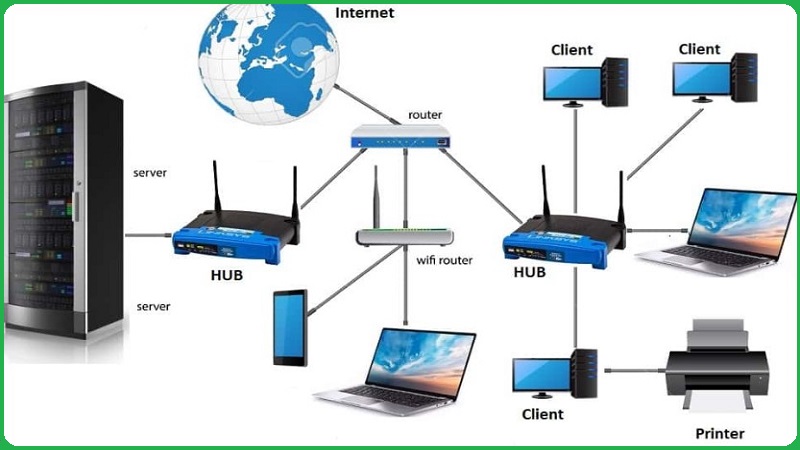What is LAN Network?
Definition of LAN: LAN stands for “Local Area Network“. LAN meaning that it works as privately network because LAN is a bunch of computer machines and other connected nodes, and they can transfer data in between entire network.
Main objective of developing of Local area network is to operate over small region like as shopping mall, office, campus etc. Main objective of using of LAN is to share resources (printer, FAX machine, plotter etc.) with multiple compute and swap data.
Diagram of LAN Network

Types of Local Area Network (LANs)
In the computer network industry, there are various types of LAN technologies. Such as –
- Ethernet is most popular as well as most useful for ordinary Computers.
- Apple Macintosh network works depend on the Apple’s AppleTalk network system that in-built into Macintosh PCs.
There are two different types of LAN connections –
Client/Server LAN: In which, various types of different devices (Clients) are connected with centralized server machine, and this server can handle several activates such as data storage, printer and plotter access, and network traffic. The Clients and Server allow to make connection each other with wired or wireless medium.
Peer-to-Peer LAN: In which, no need the centralized server machine, so it is not able to bear massive workload compare to Client/Server LAN. On this concept, each computer and other devices make connection with parallel nature.
LAN is most different from other networks on the behalf of these characteristics, such as
Topology: Topology is geometric representation of network system because on the behalf of this topology system, connected multiple computers with each other through wire or wireless medium. For examples are – Star topology, Bus topology, Ring topology, Mesh topology, Hybrid topology, and more.
Protocol: Protocol means set of rules that help to encode the all specification for sending and receiving data over network. It also checks the all types of bugs and data compression system. Some protocols are – PPP, FTP, TCP/IP, HTTP, and more.
Communication Medium: Two types of mediums are using in LAN to make link in between multiple devices, such as wire and wireless. In wire media, to use some cables like as twisted-pair wire, coaxial cables, or fiber optic.
Advantages of LAN (Local Area Network)
There are various benefits of LAN network, below explain each one –
Characteristics as well as Advantages of LAN
Resource Sharing: LAN offers to great facility resource sharing such as printer, modem, plotter, scanner, and more.
Software Program Sharing: LAN allows to use single software program with multiple computer that linked in network. So, no need to buy separate licensed application program for every client machine.
Simple and Fast Communication: In Local Area Network (LAN), huge data and other types of messages can simply share with another linked computer terminal over network.
Cost-Effective: Local Area Network (LAN) is cheapest to setup and maintain compare to other like WAN and MAN, because in LAN system no need to large cabling and other infrastructure. Due to local nature of LAN, it gets easy troubleshooting and maintenance.
Centralized Storage: All data and messages keep store in the storage medium on centralized server machine. It allows to all users for accessing of those data on the network.
Data Protection: All data save on the local server computer machine, and it is not easy task to leak those data. So LAN is more protected.
Internet Sharing: Local Area Network (LAN) offers to great functionality to share internet connection with multiple LAN connected users.
Computer Identification: Every computer machine has own MAC address that stored in the switch or router during communication between multiple computers. With the help of these MAC addresses, each client machine can identify that where to send and receive all data.
Other Advantages of LAN –
- Entire LAN setup gets small region, so it is an easy task to handle this network.
- It is easy to LAN configuration due to network operating system.
- LAN has high speed with supporting Ethernet cables. For example – in modern Ethernet version
- It can support speed up to Gigabit per second.
- Some protective protocols provide excellent security from intruders.
- Due to excellent speed, it offers to great Productivity of small or large scale organizations.
- It is great stable network compare to other like as WAN, MAN, PAN etc.
Disadvantages of LAN (Local Area Network)
There are some limitations of LAN networks such as –
Limitation of Geographical Region: Local area networks are mostly bound in small area such as in small building, school, college campus etc.
Security Issue: If the centralized sever computer is not get configured properly then its data security can be loss. So intruder can take benefits and grab your data. If anyone computer get virus then it can easily replicate entire network.
Server Dependency: If anytime centralized server computer get halt, then entire LAN system can work properly. So, entire LAN network is depending on the center server machine.
Initially LAN setup is Costly: In the starting, to establish LAN network must be special types software like as network operating system and other network hardware components such as hubs, repeaters, switches, cables etc. So these hardware and software components of networking are costly.
Privacy Broken: LAN administrator has authority to see every data of each connected user.
Examples/Uses of LAN Network
There are several examples of Local Area Network (LAN), such as –
LAN is used in different local areas like as
House Usage: LAN permits to access share files of every members in the house through internet connection.
Small Offices Usage: LAN can also use in the small office through wire or wireless network, and it allows to access all information over network.
School Area Usage: LAN is very useful technology in the school because with using it students can learn online with connecting internet.
Campus Area Usage: In the campus, every students and teachers can make connection their laptops or Smartphone with internet through Wi-Fi technology.
Embedded Systems: Embedded system means some equipment’s work automatic such as microwave and some other automatic toys. LAN system is mostly inbuilt in these types of equipment’s, so easily connected each other through WIFI system.
Some other examples are:
- Public areas – Such as cafeteria, complex mall, and more.
- Medical laboratory
- In Nuclear power system, to handle multiple equipment’s and processes.
- Smart TV is also good example.
- Two computer networking



